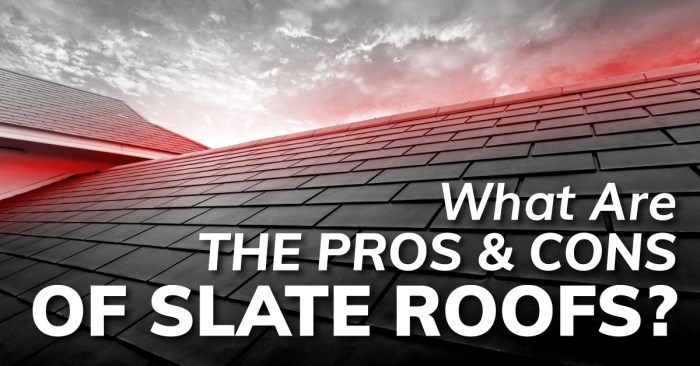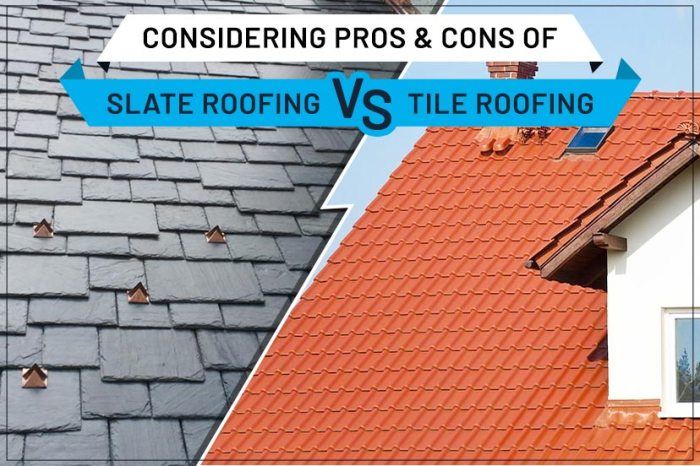Delving into the world of slate roofing pros and cons, this article provides a comprehensive look at both the advantages and disadvantages of choosing slate as a roofing material. From its durability to environmental impact, we cover it all.
Pros of Slate Roofing
Slate roofing offers a range of benefits that make it a popular choice for homeowners looking for a high-quality and long-lasting roofing option.
Durability of Slate Roofing
Slate roofs are known for their exceptional durability, with the ability to withstand harsh weather conditions such as heavy rain, strong winds, and even hail. This resilience means that slate roofs can last for decades without needing frequent repairs or replacements.
Aesthetic Appeal of Slate Roofs
One of the key advantages of slate roofing is its timeless and elegant appearance. The natural beauty of slate tiles adds a touch of sophistication to any home, enhancing its curb appeal and increasing its overall value.
Environmentally Friendly Aspect
Slate is a natural material that is sourced from quarries, making it a sustainable roofing option. Unlike synthetic materials, slate is eco-friendly and can be recycled at the end of its lifespan, reducing its impact on the environment.
Long Lifespan of Slate Roofs
Compared to other roofing materials like asphalt shingles or metal, slate roofs have an exceptionally long lifespan. With proper maintenance, a well-installed slate roof can last over a century, providing long-term cost savings and peace of mind for homeowners.
Cons of Slate Roofing

Installing a slate roof can come with some drawbacks that homeowners should consider before making a decision.Slate roofing is known for its high cost, making it one of the most expensive roofing materials available. The initial investment required for a slate roof can be a significant deterrent for many homeowners on a budget.
Weight of Slate Roofing
Slate tiles are heavy, and this weight can put a strain on the structure of a building. Not all homes are built to support the weight of a slate roof, so additional reinforcement may be necessary before installation. This added structural work can further increase the overall cost of the project.
Potential for Breakage and Repair Difficulty
Slate tiles are fragile and can break if stepped on or struck by heavy objects such as tree branches. Repairing broken or damaged slate tiles can be challenging and may require the expertise of a professional roofer. Finding matching replacement tiles can also be difficult, leading to aesthetic inconsistencies on the roof.
Limited Availability of Slate
Slate is a natural material that is sourced from quarries, and its availability can be limited depending on the region. This limited availability can lead to delays in roofing projects or difficulty in finding a consistent supply of high-quality slate tiles.
Additionally, transportation costs for importing slate can add to the overall expense of the project.
Maintenance of Slate Roofing
Maintaining a slate roof is essential to ensuring its longevity and performance. Regular inspections, addressing maintenance issues promptly, and following proper cleaning methods are crucial in preserving the beauty and functionality of a slate roof.
Tips on How to Maintain a Slate Roof
- Inspect the roof at least twice a year, especially after severe weather conditions.
- Replace any broken or missing slates immediately to prevent water leaks.
- Trim overhanging branches to prevent damage from falling debris.
Importance of Regular Inspections for Slate Roofs
Regular inspections help identify any potential issues early on, allowing for timely repairs and preventing costly damage. It also ensures that the roof remains structurally sound and secure.
Common Maintenance Issues Specific to Slate Roofing
- Cracked or missing slates
- Loose or damaged flashing
- Clogged gutters causing water backup
Recommended Cleaning Methods for Preserving a Slate Roof
When cleaning a slate roof, avoid using pressure washers or harsh chemicals that can damage the slate. Instead, opt for gentle cleaning solutions and soft brushes to remove debris and prevent moss or algae growth. Regular cleaning helps maintain the appearance and integrity of the slate roof.
Installation Process of Slate Roofing
Installing a slate roof is a meticulous process that requires expertise, the right tools, and materials to ensure a durable and beautiful finished product.
Steps Involved in Installing a Slate Roof
- Preparing the Roof Deck: The existing roof must be stripped down to the deck, which should be inspected for any damage and repaired if necessary.
- Installing Underlayment: A waterproof underlayment is placed over the deck to provide an additional layer of protection against water infiltration.
- Laying the Slate Tiles: Each slate tile is carefully placed and secured using copper nails to ensure proper alignment and prevent shifting.
- Adding Flashing and Ridge Caps: Flashing is installed around roof penetrations and valleys, while ridge caps are placed along the peaks of the roof for added protection.
- Finishing Touches: The roof is inspected for any loose tiles or imperfections before the final clean-up is done.
Expertise Required for Proper Slate Roof Installation
Proper installation of a slate roof requires a skilled roofer with experience working with this type of material. Knowledge of the correct techniques for laying and securing slate tiles is essential to ensure a long-lasting and effective roof.
Tools and Materials Needed for a Slate Roofing Project
| Tools | Materials |
|---|---|
| - Slate Ripper- Roofing Hammer- Copper Nails- Roofing Saw | - Slate Tiles- Underlayment- Flashing- Ridge Caps |
Timeline for Installing a Slate Roof and Any Challenges Involved
The timeline for installing a slate roof can vary depending on the size of the project and the weather conditions. Typically, it can take several weeks to complete a slate roofing project. Challenges may include the weight of the slate tiles, which can make handling and installation more labor-intensive, as well as the fragility of the tiles, requiring careful handling to prevent breakage.
Final Summary

In conclusion, slate roofing offers a unique blend of longevity and elegance, but comes with its own set of challenges like high costs and limited availability. By weighing the pros and cons carefully, homeowners can make an informed decision on whether slate roofing is the right choice for their needs.
FAQ Summary
What is the average lifespan of a slate roof?
A properly maintained slate roof can last over 100 years, making it one of the most durable roofing options available.
Is slate roofing environmentally friendly?
Yes, slate is a natural material that can be recycled and is energy efficient, making it a sustainable choice for environmentally conscious homeowners.
How often should a slate roof be inspected?
It is recommended to have a professional inspection of your slate roof at least once a year to catch any potential issues early on.














